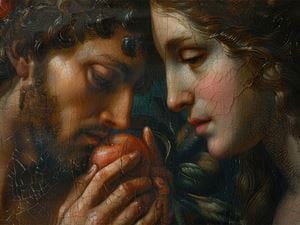
Did Adam and Eve, the first humans and the first sinners in history, find redemption and enter heaven?
The question of whether Adam and Eve were ultimately saved has intrigued theologians and believers for centuries. While the Bible does not explicitly state their fate, the story of their sin and God's response lays the foundation for understanding humanity’s need for redemption.
Creation of Humanity
The Bible says that in the beginning, God created humans. Genesis 1:26-27 states that God made man in His own image, after His own likeness. He created humanity as both male and female. This was God's original design and ongoing intent for His highest creation—humanity. God gave humans dominion over creation and placed them as the crown jewel of the Garden, which represented all of God's Creation. Yet, this was not enough for God's most blessed creation. They didn't just want to be with God; they wanted to be God.
The Command and Temptation
God told Adam and Eve they could eat from any tree in the Garden, except for the tree of the knowledge of good and evil. If they ate from this tree, they would surely die—a concept they had no experience or awareness of in their lives.
Despite this limitation, the Bible tells us that the Serpent came to Eve to tempt her to eat from the tree of the knowledge of good and evil. He initiated a conversation by questioning what God had said to her. He questioned the integrity of God's words and modified them slightly, as he is prone to do throughout human history.
The Deception
The Serpent told Eve that God had commanded her not to eat from the tree of knowledge of good or evil, nor even to touch it. However, God never told her she couldn’t touch it. The Serpent, a master at deception, knows how to increase interest in disobedience. Eve took the bait of Satan. The Serpent reassured her that she would surely not die if she ate from the tree and that she would gain knowledge, becoming “like God.”
It was those last two words—"like God"—that ensnared her. She desired not just to be with God but to be God. She ate the fruit and gave some to Adam, who also ate. Immediately, they realized they were naked and felt ashamed. The knowledge they gained through disobedience brought them shame, embarrassment, and fear, so they hid themselves.
Consequences of Sin
God came looking for them, but Adam and Eve, afraid, hid from an all-knowing, all-seeing God. When God called for them, they admitted their fear and why they had hidden. God, already aware of what they had done, asked them to explain. Each of them blamed someone else—Adam blamed Eve, and Eve blamed the Serpent.
As a result, God pronounced judgment on all involved. Adam would have to work by the sweat of his brow, and the land would be cursed. Eve would experience pain in childbirth. The Serpent would crawl on its belly for all time. Sadly, the curse of sin was passed on to all of humanity from that day forward.
Hope in God's Redemption
Although Adam and Eve would face the consequences of their sin for the rest of their lives, there was still hope. God, while being a God of judgment, is also a God of redemption. He is always redeeming humanity from the mess it has made of itself.
Genesis 3:21 tells us, “And the Lord God made for Adam and for his wife garments of skins and clothed them.” God did not leave Adam and Eve in their shame, fear, or self-destruction. He rescued them by clothing them with physical garments, which would later symbolize the transformation from cursed to saved.
Symbolism of Clothing
Isaiah 61:10 says, “I will greatly rejoice in the LORD, my soul shall be joyful in my God; for he hath clothed me with the garments of salvation, he hath covered me with the robe of righteousness.” This is what God did for Adam and Eve—He covered them with garments of salvation and robes of righteousness.
Nowhere in the Bible does it explicitly say, "Adam and Eve went to heaven when they died," or that they were saved from their sin. However, Genesis 3:21 shows what God did for them and builds on this imagery in Isaiah and later, in the New Testament, under the authority and finished work of Jesus Christ on the cross. Jesus employs similar language in the story of the Prodigal Son, where the father clothes the rebellious returning son in a robe, symbolizing forgiveness and redemption.
Redemption for Humanity
Revelation 19:6-8 tells us that those who believe in Jesus are invited to the marriage supper of the Lamb and will be clothed in robes representing the righteous deeds of the saints. While the Bible does not explicitly state that Adam and Eve were saved, the text suggests their redemption in Genesis 3:21 was a foundational example for all of humanity throughout history.
Just as Adam and Eve sinned, so has everyone else since. All humanity must confront the brokenness of sin and the need for redemption—the need for God to bruise the head of the Serpent. God fulfilled this promise through Jesus on the cross. Jesus’ death defeated the works of the Serpent and provided a way for humanity to escape eternal damnation, offering grace and redemption to all.
The Grace of Jesus Christ
Jesus offers grace and forgiveness for sins we cannot atone for ourselves. However, this grace requires repentance—confession of sin and a declaration of who Jesus is. Repentance requires acknowledgment, as Adam and Eve had to admit, that we are sinners in need of a Savior. Through repentance, Jesus offers forgiveness and new robes of righteousness.
All anyone must do is come to the Lord and say, “I was ashamed, and so I hid.” And God will say, “Come to me, and I will clothe you anew through my Son, Jesus Christ, who paid the penalty for your sins.” This is the good news of the Gospel—this is what Jesus offers to all who repent and believe. This is what God did for Adam and Eve, and He can do the same for you too.

